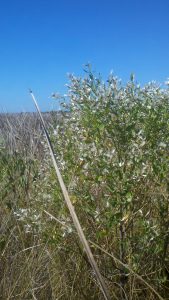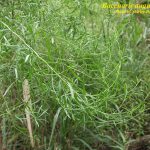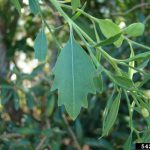
Saltbush seed in “bloom” stands out in a salt marsh dominated by black needlerush. Photo credit: Zach Schang, FDEP
In the spring and summer, no one notices the little green shrub hidden among wax myrtle and marsh elder at the edge of the salt marsh. However, if I’m leading a group of students or a Master Naturalist class through the same area in the fall, it’s the first plant people ask about. The saltbush or groundsel tree (Baccharis halmifolia) blooms dramatically in late September and October, with feathery, dandelion-like white “flowers” on female plants. These seeds are dispersed far and wide by the wind. Male plants typically grow side-by-side with females, and produce yellowish, tubular blooms at the same time. Characterized as both a large shrub and a small tree, the saltbush typically branches from multiple trunks and ranges in height from 2-10 feet. The leaves are rough to the touch and slightly succulent, enabling the plant to hold onto moisture in the sandy, hot environments on the uphill edges of wetlands in which it thrives.

The leaf of Baccharis angustifolia is narrower than B. halmifolia. Both are succulent, enabling the plants to hold on to moisture in a salty environment. Photo courtesy Shirley Denton, Florida Plant Atlas.

The leaf of Baccharis halmifolia is lobed and wider than B. angustifolia is narrower. Both are succulent, enabling the plants to hold on to moisture in a salty environment. Photo courtesy Forestry Images.
The plant is often confused with its near relative, false willow (Baccharis angustifolia), which is typically co-located with saltbush in coastal wetlands. It also blooms white in the fall, but can be differentiated by its slender, almost needle-like (but also succulent) leaves.
Saltbush is not typically used in the home landscape, as some people are allergic and the seeds are poisonous if ingested. Properly planted, however, it is a perfect addition to a butterfly garden because the male plants’ fall flowers provide nectar to numerous butterfly species, including the monarch. Another ideal location for saltbush would be a rain garden or the edges of a stormwater pond. Coastal property owners on the bay or Gulf would find it an excellent addition due to its tolerance of the year-round salt spray. The species is very hardy–tolerant of both wet and dry soils–along with a variety of soil pH levels. Plant saltbush in full sun with at least 3-5 feet between young plants.
For additional information on the characteristics of saltbush, please see the UF publication, Baccharis halmifolia Saltbush, Groundsel Bush and check out this entertaining video from our Lee County colleague, Stephen Brown, as he immerses himself in a stand of saltbush.
- Rosemary - March 7, 2024
- The Franklin Tree - January 18, 2024
- Yaupon Holly - January 4, 2024
